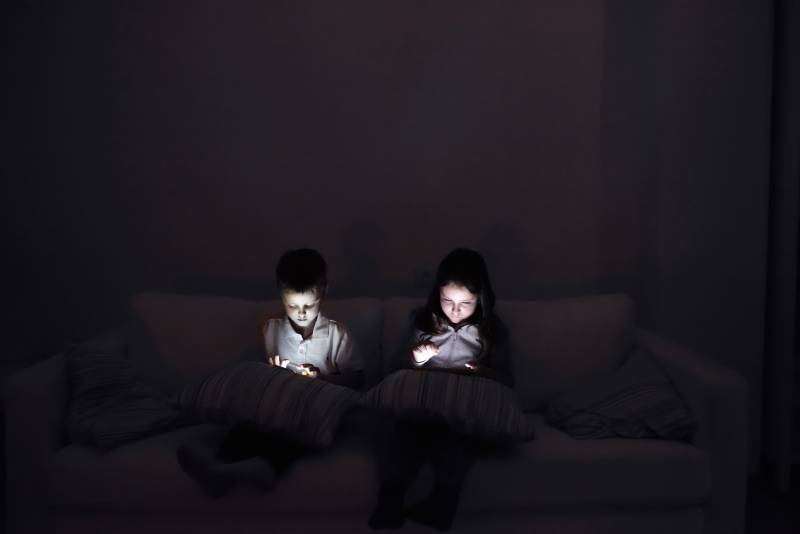Still, today’s caregivers are raising kids in a world that offers more and more ways to get hooked on screens. According to a recent study, teenagers spend nearly eight hours a day on recreational screen time. However, if parents and caregivers understand what is happening in a child’s mind when they are overusing screens , caregivers can support children in cultivating healthier practices and better relationships to devices.
Social Media and the Brain
At the crux of behaviors – like an inability to tear oneself away from YouTube or stop scrolling through a phone – is brain chemistry, specifically a spike in a chemical called dopamine. “It is released in response to things that are pleasurable, things that are rewarding and things that are novel or different,” Lembke said. Substances and behaviors that are more addictive release higher than usual amounts of dopamine in the part of our brains called the reward pathway.
Social media platforms in particular tap into a human need to connect with other people, said Lembke in “The Social Dilemma,” a Netflix documentary about social media and search platforms. Technology enables people to connect across geography and disability as well as find and form meaningful communities.
“During the pandemic, that was really proved true because these are incredible tools that adults use for very good purposes: for creativity, to connect with others, to perform the work that they need to do and to enjoy themselves,” said Kamenetz.
These devices and the apps on them are deeply, inherently reinforcing, according to Lembke. “The way that they’ve been created immediately taps into our dopamine reward pathway and we are engaged,” she said. While dopamine and the enjoyable experiences that cause it are not inherently bad, pleasure and pain are co-located in the brain, meaning you can’t have one without the other.
Much like a sugar crash after eating a bunch of Halloween candy, a big surge of dopamine is followed by a dip in dopamine levels that go below their initial baseline.
“When we release a large amount of dopamine in response to a highly reinforcing drug or behavior, our brain has to compensate,” said Lembke.
For instance, YouTube and TikTok will automatically generate videos, so that users are more likely to keep watching for hours on end. “Which in and of itself releases dopamine, followed by a dopamine deficit state which has us pressing that lever, which is what we all do when we’re looking for that next video,” said Lembke.
If a person continues to do addictive behaviors that cause their dopamine levels to skyrocket, they’ll begin to build up a tolerance. “Ultimately, we can end up in this chronic dopamine deficit state where we’re not making much of our own dopamine,” said Lembke. “Now we’re using just to get out of withdrawal to temporarily restore a baseline level.”
When young children are in a prolonged dopamine deficit state they may develop depression or generalized anxiety symptoms. Other activities will seem less appealing and they may lose their ability to wait for long term rewards.
Strategies for limiting screen time
Most adults who have tried to take away an iPad from a child or turn off the television would like to avoid the tantrum that usually follows. Parents and caregivers often feel that they can’t enforce rules or set guidelines because they are concerned that they’ll do or say something that will leave their child with emotional damage or a longstanding illness, according to Lembke. “It’s really hard to take those things away. It feels harsh and punitive,” she said. “But in fact you’re doing your kids a favor when you’re helping them create guardrails around how they’re using their devices.”
While there is no hard and fast rule about how much screen time a child should have at each age, Dr. Lembke suggests not giving kids personal devices until they are at least 10 years old. Instead of creating strict screen time limits, Kamenetz urges parents to first take stock of how their kids spend time, assessing if they are getting sufficient sleep, playing outside, hanging out with friends and enjoying time with family.
“It’s like crowding out your plate with vegetables,” said Kamenetz, referring to the tech analogy of a well-balanced diet, and structuring children’s time with healthy activities. “Then you’re like, ‘OK, well, where does the screen time fit in?’”
Parents are also quick to point the finger at children’s excessive screen time, when they, too, could benefit from reevaluating their tech use. Alternatively, caregivers can model the relationship to technology they’d like their kids to have.
“The groundwork is laid in the very early years and it’s not the kids. It’s the parents who are doing it,” said Kamenetz. “Our kids are put on this planet to help us understand the consequences of our actions.”
She recommends creating a family media plan where all family members set standards for how and when devices will be used. “You should all have expectations around how you’re going to guard and protect the media free time in your day and your week.”
In more severe cases – such as those that qualify within the 4Cs – Lembke suggests encouraging children to take a break from using the device altogether. Even just putting away screens for one day can provide useful information, said Lembke. “Twenty-four hours is certainly enough to be able to observe our own attachments to our devices, and the anxiety that we feel while abstaining.”
However, it takes around 30 days for the dopamine levels to go back to normal if a person was in a dopamine deficit state. “It’s worth doing the full 30 days because if you do too little, all you’re going to get is the withdrawal part,” she said. “And it’s key to go long enough so that people can notice the benefits and then are motivated themselves to change their relationship with their device.” If a child still seems depressed or anxious at the end of the 30-day period, Lembke recommends consulting a mental health professional to see what additional support the child might need.
Most kids, especially ones who are in the throes of addiction, aren’t likely to give up their device willingly. Developmentally, kids don’t usually think in the long term, so it’s hard for them to realize that behaviors can be harmful further down the line.
“They only see the positives of their use,” said Lembke about kids experiencing addiction. If a child is feeling doubtful about taking a break from screens or any other addictive behavior, Lembke suggests inviting kids to think about the future and consider the full arc of their lives. Asking questions about their overuse of devices or harmful behavior like “Do you want to be doing this in ten years?” “Do you want to keep doing this in five years?” and “Do you want to be doing this a year from now?” can be a helpful way to energize kids to try something new.
One set of strategies for abstaining or putting limits on addictive behavior is self-binding. “It’s the way we intentionally create barriers between ourselves and our drug of choice,” said Lembke. Self-binding falls into three categories: space, time and meaning.
Space
Focusing on space for self-binding means limiting the access you have to an object with physical barriers. For example, a parent or child might put their phone or gaming console in a container with a lock or in a different room. Space self-binding techniques acknowledge that sometimes willpower doesn’t cut it if the temptation is too great. Some self-binding examples from Lembke’s patients include unplugging the TV and putting it in the closet and keeping their gaming console stowed away in the garage.
Time
Time self-binding uses time limits and finish lines or milestones to control misuse. “We narrow our window of consumption and thereby limit our use,” wrote Lembke in her book. For example a child might decide to delete an app on their phone until after they finish finals or choose to only play video games on the weekend. Even just tracking how much time is spent being on a device can be really helpful for children because they often don’t realize how much it is. Time self-binding is also helpful for building up kids capacity to delay gratification, which is linked to better social adjustment.
Meaning
Using meaning to self-bind involves creating categories to identify what a person will allow themself to consume and what they’ll avoid. For example, Lembke worked with a young man who wanted to stop gaming. He decided to stop using screens altogether because he felt he might start watching people play video games and then he would want to play video games. “This method helps us to avoid not only our drug of choice but also the triggers that lead to craving for our drug,” she said.
The majority of young people will be able to self-correct if they are misusing substances or doing harmful behaviors, said Lembke. “But for those who cannot, we need to help them.” She urges parents to trust their instincts. “If you see your kid is circling the drain, I just really encourage you to gently, but firmly, intervene.”



